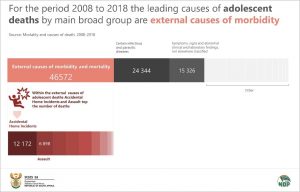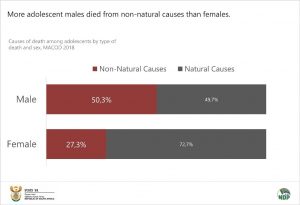The Young and the Restless – Adolescent Health in SA
In South Africa, adolescents aged 10-19 represent a significant proportion of the population at 17,4% and contribute to 2,1% of the total mortality. The health and well-being of adolescents is of particular importance in society as they represent the future work force and contributors to potential economic productivity. However, adolescents may face many challenges such as mental health issues, alcohol and tobacco use, and early and unprotected sex with multiple partners, which carries a high risk of acquiring HIV infections and other sexually transmitted infections as well as teenage pregnancy.
Generally considered as the phase or transition of life between childhood and adulthood, adolescence is typically characterised by the onset of teen hormones and growth spurts; adolescents usually experience rapid physical, cognitive and psychosocial growth. A new report released by Statistics South Africa, Profiling health challenges faced by adolescents (10-19 years) in South Africa, focuses on health challenges, including mortality, faced by adolescents aged 10-19 years in South Africa.
According to the results, the leading causes of adolescent deaths by main broad group are external causes of morbidity (comprising accidents occurring at home or place of residence, assault, contact with an object and traffic accidents), followed by certain infectious diseases that include intestinal infectious diseases, tuberculosis and HIV, and respiratory system diseases led by influenza and pneumonia.
External causes of morbidity contributed 46 572 deaths to the total number of deaths among adolescents between 2008 and 2018. Certain infectious diseases recorded deaths of nearly 25 000, while the remaining broad groups reported less than 10 000 deaths per group. The majority of external causes of morbidity and mortality are accidents that occur at home, school or other place of residence, assault, contact with an object (sharp or blunt), traffic accidents, exposure to mechanical objects such as gun shots, accidental drowning, exposure to smoke or fire, intentional self-harm and exposure to forces of nature such as lightning.
External causes of mortality are also known as non-natural causes because they are not a result of a health condition or illness. The report shows that accidental incidents occurring at home are the leading external cause of deaths (12 172), followed by assault at 6 898. Contact with an object (5 529), other threats to breathing and traffic accidents also contributed to external causes of mortality amongst adolescents. Intentional self-harm and exposure to forces of nature contributed less than 1 000 deaths to the total deaths among adolescents between 2008 and 2018.
More adolescent males died from non-natural causes than females. Over 80% of violence-related causes of death, assault and injuries following exposure to mechanical force such as gunshot wounds, occurred in males. A similar trend is observed for road traffic accidents, with males accounting for over 60% of the fatalities compared to their female counterparts.
However, adolescent girls face additional threats at puberty. A total of 106 383 registered live births occurred among adolescents 10-19 years in 2019. Among registered live births that occurred among adolescents, KwaZulu-Natal recorded a higher percentage than other provinces at 24,7%. It was the only province with registered live births above 20%. KwaZulu-Natal was followed by the Eastern Cape and Limpopo, both at 14,4%, Gauteng at 13,7% and Mpumalanga at 10,0%. The remaining provinces reported less than 10% of registered live births with Western Cape at 8,3%, Free State at 4,8%, North West at 6,3% and Northern Cape with the lowest percentage of 3,2%.
The South African Constitution guarantees all women the right to make decisions concerning reproduction. The introduction of the Choice on Termination of Pregnancy (TOP) Act 92 of 1996 means that all women, irrespective of race, age, geographical location or socio-economic status can access a safe and legal termination of pregnancy1. Nationally, the rate of TOP among women aged below 20 years was around 12% for all the reporting years, showing a slight increase from 2017 (12,1%) to 2019 (12,9%). In the three reporting years, the highest rates of TOP were observed in Limpopo. In 2017 and 2018, North West had the lowest proportions of TOPs, whilst for 2019, the lowest rate was recorded in KwaZulu-Natal. Termination of pregnancy rates were seen to consistently increase in the Western Cape, Free State, North West and Limpopo.
While almost half of female adolescents (49,8%) consulted a health worker when they were sick as compared to their male counterparts (45,1%), access to medical aid varied considerably by population group, with almost 75% of adolescents from the white population group covered by a medical aid/scheme while slightly over 50% of adolescents from the Indian/Asian population had access. Less than 20% of adolescents from coloured population group and only 9,3% of the black African population group had access to medical aid. These disparities in medical aid access influence the health-seeking behaviour of adolescents. The proportion of adolescents who consulted a health worker when they were ill was highest for those from the white population group, followed by those from the Indian/Asian, coloured and black African population groups.
Health is determined by complex interactions between social and economic factors, the physical environment and individual behaviour. This report covers access to safe water, access to improved sanitation, and poverty. The overall health challenges include: medical aid coverage, teenage pregnancy and births in facilities, termination of pregnancy, male circumcision, cancer, mental health, disability, road traffic fatalities and causes of death. For more information on these topics download the full report here.
1 https://static.pmg.org.za/docs/2000/appendices/000608CLC.htm



